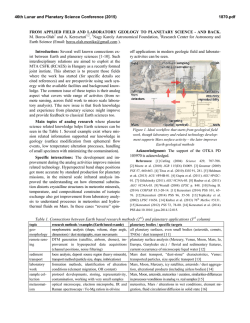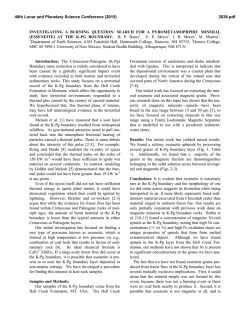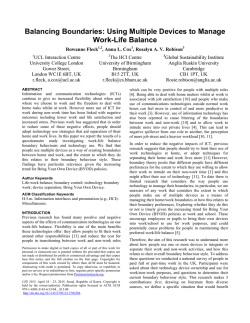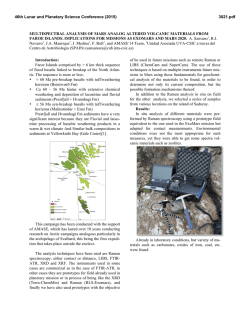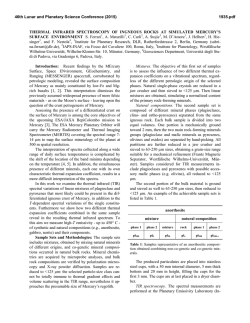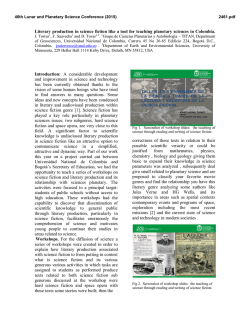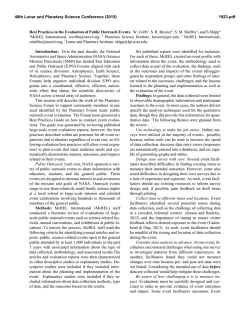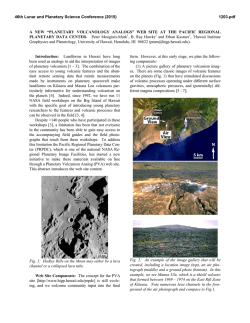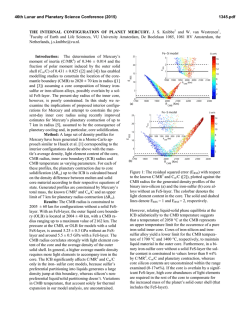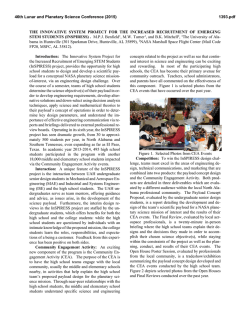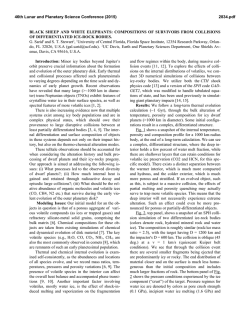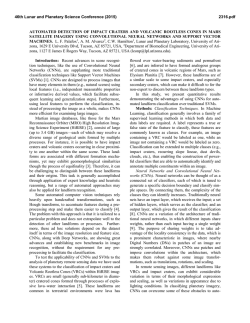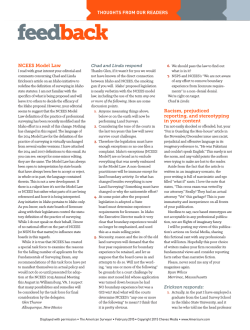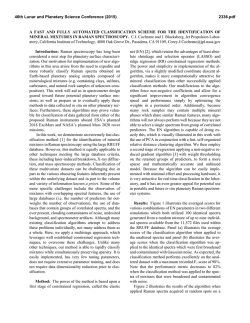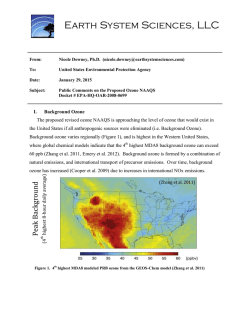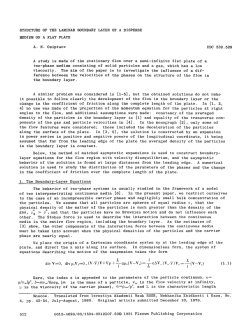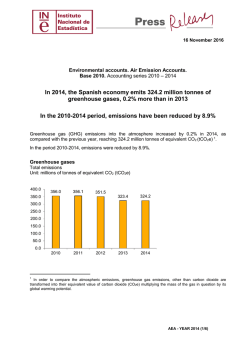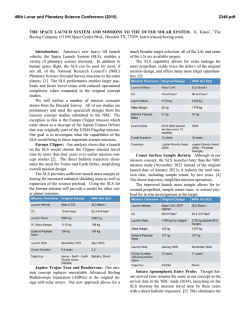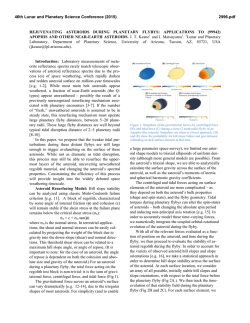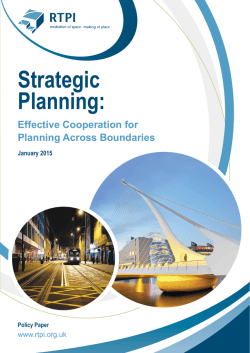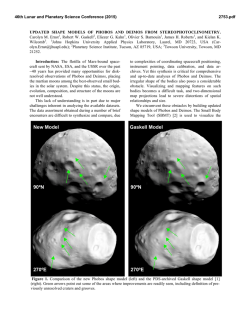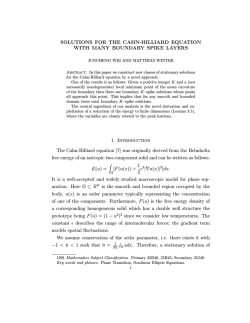
Planetary Boundaries for Business
Planetary Boundaries A Safe Operating Space for Humanity Interfering with nature’s dynamics creates new global environmental risks – and the trends are already serious. Business plays a vital role in responding sustainably to these challenges. • • • The Planetary Boundaries framework for global environmental sustainability uses the most recent scientific data. The recent update has been published as a peer-‐reviewed scientific article in top international journal Science. The new analysis is led by Stockholm Resilience Centre scientists working with an international team of experts. The Planetary Boundaries framework1 sets out precautionary boundaries for nine critical processes of human-‐driven environmental change. Beyond these boundaries, we all face the possibility of abrupt, large-‐scale changes in Earth system functioning and significant risks to societies and economies worldwide. Together, the Planetary Boundaries quantify a safe operating space at the global level, providing a dashboard for global sustainability. The Planetary Boundaries framework was first launched in 2009. Behind the framework lies over 50 years of international scientific effort to understand physical climate, geochemical and ecological processes and their driving forces. The framework has been influential in many sustainability forums. It informed the natural capital priority areas for Action2020.org, a global platform for action led by the World Business Council for Sustainable Development and its members. It features in the ongoing development of worldwide Sustainable Development Goals. Four boundary processes (climate change, land use, biodiversity loss, water use) relate directly to goals. The remaining planetary boundaries are addressed in targets and indicators of the other SDGs. Key Updates: Planetary Boundaries 2.0 1. Four planetary processes are already entering the scientifically assessed global risk zone. Land use change is a new boundary that is estimated to be past the safe threshold, joining climate change, loss of biosphere integrity, and an overload in the nitrogen and phosphorus biogeochemical cycles. 2. Regional hotspots have been mapped. Regional changes in several boundary processes, notably freshwater use and atmospheric aerosol loading may have global consequences if action is not taken to address the trends. This mapping also helps link local choices to global risks. 3. Two boundary processes have been re-‐scoped and renamed. The updated Changes in biosphere integrity now focuses on the functions of ecosystems, as well as their biological diversity. Introduction of novel entities highlights the need to tackle environmental releases of toxic chemical pollutants, and also considers how other kinds of physical and biological interventions can have global impacts. Contact us: [email protected] www.stockholmresilience.org A PARTNER WITH To measure true progress toward sustainability, businesses need to benchmark collective performance against the physical and ecological limits of the planet. While science can’t always predict catastrophic changes, it can identify to likely risk scenarios. Below is a summary of the business implications of Planetary Boundaries 2.0. What are the planetary boundaries? What does this mean for business? Climate change Global temperature has risen by nearly 0.7°C since 19502, mostly due to CO2 emissions from fossil fuel use. Boundary: atmospheric concentration no higher than 350 ppm CO2 Current: 400 ppm CO2 and rising CO2 emissions must decrease, soon and sharply. Climate change, energy security and economic stability are tightly linked. Assets and business activity will be affected by rising temperatures, more frequent weather extremes, and sea-level rise. Loss of biosphere integrity Wild animal populations have roughly halved since 1970, and ecosystems worldwide have been impacted by human activities.3 Boundary: no more than 10 extinctions per million species-years Current: ~1000 E/MSY and rising (plus regionally determined boundaries for ecosystem function) Business cannot function if ecosystems are degraded or out of balance. Nature provides directly beneficial services – food, fibre, fuel. It also provides many invisible but essential services, such as regulation of climate and the water cycle, air quality improvements, flood protection. It also contributes to cultural and individual wellbeing. Changes to biogeochemical flows – nitrogen and phosphorus N and P are essential nutrients for all life. Exponential rises in N and P emissions from industry and intensive agriculture kill lake and marine life, cause severe air pollution and affect climate patterns.4 P Boundary: no more than 6.2 million tons P applied to land per year Current: ~14 Mt yr-1 and rising N Boundary: no more than 62 million tons N applied to land per year Current: ~150 Mt yr-1 and rising Humanity faces a global challenge to produce more food and energy without eroding its ecological life-support systems. Global disparities in food and energy security are severe. The environmental release of N and P is becoming an unaffordable waste of natural resources. Land use change (forest conversion to croplands, roads and cities) As well as killing wildlife, deforestation and urbanization affect climate by changing CO2 flows.1, 2. Boundary: no less than 75% biome intactness Current: 62% and shrinking Business has caused a significant part of the world’s large-scale land degradation and deforestation. It can make a major difference by adopting and promoting sustainable land management practices and policies. Release of novel entities Synthetic substances – and even novel life-forms – can radically alter Earth’s biological and physical dynamics, bringing entirely new systemic risks to human societies. Multiple boundaries, yet to be quantified Business plays a unique role as the producer of novel entities, many of which are essential in modern society (medicine, agriculture, consumer goods, new technologies). Urgent reduction in releases of harmful substances means a renewed focus on sound chemicals management by business. Atmospheric aerosol loading Microparticles emitted into the air cause severe local pollution problems that can cascade up to global impacts on nature and climate. Regionally determined. e.g., boundary for South Asia: Aerosol Optical Depth 0.25 Current: AOD 0.30 (‘brown cloud’) Atmospheric aerosols have complex impacts, but all business action to address air pollution at the local level to is likely to help tackle the systemic global problem too. Avoid “exporting pollution” by shifting manufacturing to places with lax regulatory controls. Freshwater abstraction Water use impairs or even dries up rivers and aquifers, harming the environment and altering the hydrological cycle and climate. Global boundary: 4000 km3 water use per year Current: 2600 km3 yr-1 River-basin boundaries also defined. All business action at the local level to minimise water waste and reduce the release of pollutants into the environment will help to reduce pressure on the planetary boundary. Ocean acidification due to fossil fuel CO2 Tightly coupled to climate change, today’s rate of ocean acidification is unprecedented in over 65 million years. Effects on marine life are already evident.5 Boundary: ≥80% of pre-industrial ocean ΩCaCO3 Current: ~84% of pre-industrial ocean ΩCaCO3 The rise in carbon dioxide emissions must halt – and the sooner, the better. Delaying the CO2 emissions peak will require higher mitigation rates, with higher costs and higher climate risks. Loss of stratospheric ozone due to CFCs The ‘ozone hole’ allows more harmful UV light to reach Earth’s surface. The minimum ozone concentration has now been steady for ~15 years after the phasing out of ozone depleting substances.6 Boundary: no lower than 276 DU ozone (latitude-dependent) Current: 283 DU and improving This is often seen as a success story, but the good work to reduce environmental release of ozone depleters must continue7. Avoid “exporting pollution” by continuing use of these substances in places not yet subject to international regulatory controls. 1 J. Rockström and colleagues developed the original Planetary Boundaries framework, published in 2009 in the international scientific journal Nature, issue 461, pages 472-‐475, http://www.nature.com/nature/journal/v461/n7263/full/461472a.html. 2 Intergovernmental Panel on Climate Change Fifth Assessment Report, Climate Change 2014: Synthesis Report. www.ipcc.ch/pdf/assessment-‐ report/ar5/syr/SYR_AR5_LONGERREPORT_Corr2.pdf 3 WWF Living Planet Report 2014, http://wwf.panda.org/about_our_earth/all_publications/living_planet_report; Millennium Ecosystem Assessment 2005, Ecosystems and Human Wellbeing www.millenniumassessment.org 4 Global Partnership on Nutrient Management 2013, Our Nutrient World. www.initrogen.org/sites/default/files/documents/files/ONW.pdf 5 Intergovernmental Panel on Climate Change Fifth Assessment Report, Climate Change 2014: Working Group II, Impacts, Adaptation, and Vulnerability. Chapter 6. http://ipcc-‐wg2.gov/AR5/report 6 NASA, Watching the ozone hole before and after the Montreal Protocol. http://earthobservatory.nasa.gov/IOTD/view.php?id=79198 7 UNEP 2012, The Montreal Protocol and the Green Economy, http://www.unep.org/ozonaction/Portals/105/documents/publications/green-‐economy-‐ report.pdf
© Copyright 2025
